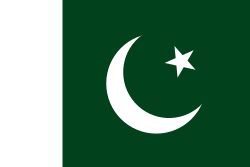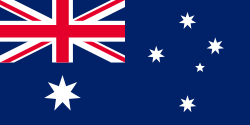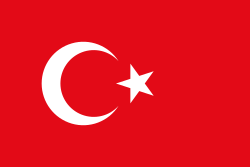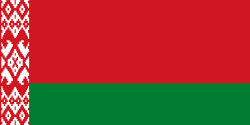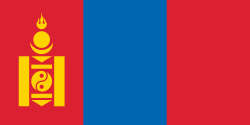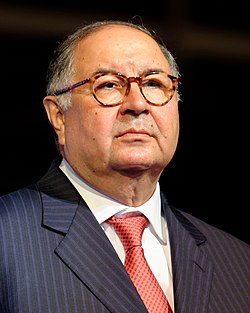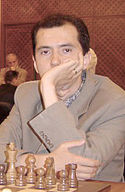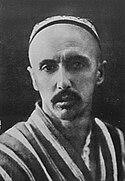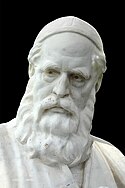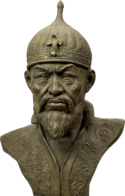Uzbeci
| Uzbeci Oʻzbeklar | |
|---|---|
| Populace | |
| celkově 28–30 millionů | |
| 23–24,8 milionů[1][2] | |
| 2,5–3,5 milionů[3][4] | |
| 1–1,164 milionů[5][6] | |
| 780 000–900 000[7][8] | |
| 490 000–650 000[9][1] | |
| 260 000–480 000[10] | |
| 299 862[11] | |
| 70 133–80 000[12] | |
| 14 800–24 800[13] | |
| 13 000–22 400[2][14] | |
| 5 000–20 000 | |
| 15 960–20 000[15] | |
| 5000[16] | |
| 1593[16] | |
| 560[17] | |
| 521 | |
| Jazyk(y) | |
| uzbečtina | |
| Náboženství | |
| sunnitský islám | |
| Příbuzné národy | |
| Ujgurové, Tataři | |
Uzbeci (O‘zbek / Ўзбек, plurál O‘zbeklar / Ўзбеклар) jsou turkický národ čítající asi 23 až 30 milionů lidí. Žijí především ve Střední Asii, ale jejich diaspora se dá rovněž nalézt v Severní Americe, Turecku, Saúdské Arábii nebo Západní Evropě. Jejich jazykem je uzbečtina.
Některé známé osobnosti
- Tamerlán (1336–1405), vojevůdce a dobyvatel
- Ulugbeg (1394–1449), Tamerlánův vnuk a dědic jeho říše
- Alíšer Navoí (1441–1501), básník a politik
- Muhammad Šejbání (1451–1510), vojevůdce a chán
- Bábur (1483–1530), indický vládce a zakladatel Mughalské říše
- Islam Karimov (1938–2016), prezident Uzbekistánu v letech 1991–2016
- Ališer Usmanov (* 1953), ruský podnikatel uzbeckého původu
- Rustam Kasimdžanov (* 1979), šachový velmistr a mistr světa FIDE v letech 2004–2005
Odkazy
Reference
- ↑ D. Carlson, "Uzbekistan: Ethnic Composition and Discriminations", Harvard University, August 2003
- ↑ CIA factbook 2005 - Uzbekistan. www.cia.gov [online]. [cit. 2013-01-24]. Dostupné v archivu pořízeném dne 2016-07-09.
- ↑ CIA World Factbook – Afghanistan. www.cia.gov [online]. [cit. 2013-01-24]. Dostupné v archivu pořízeném dne 2017-09-20.
- ↑ CIA factbook 2005 - Afghanistan. www.cia.gov [online]. [cit. 2013-01-24]. Dostupné v archivu pořízeném dne 2017-09-20.
- ↑ CIA World Factbook – Tajikistan. www.cia.gov [online]. [cit. 2013-01-24]. Dostupné v archivu pořízeném z originálu dne 2007-06-12.
- ↑ CIA factbook 2005 - Tajikistan. www.cia.gov [online]. [cit. 2013-01-24]. Dostupné v archivu pořízeném z originálu dne 2007-06-12.
- ↑ CIA World Factbook – Kyrgyzstan[nedostupný zdroj]
- ↑ CIA factbook 2005 - Kyrgyzstan. www.cia.gov [online]. [cit. 2013-01-24]. Dostupné v archivu pořízeném dne 2015-11-27.
- ↑ Ethnic groups in Kazakhstan, official estimation 2010-01-01 based on National Census 2009. www.stat.kz [online]. [cit. 2013-01-24]. Dostupné v archivu pořízeném dne 2010-02-08.
- ↑ CIA factbook 2005 - Turkmenistan. www.cia.gov [online]. [cit. 2013-01-24]. Dostupné v archivu pořízeném dne 2007-06-12.
- ↑ Russia Census 2002. www.perepis2010.ru [online]. [cit. 2013-01-24]. Dostupné v archivu pořízeném dne 2011-08-21.
- ↑ Rhoda Margesson (January 26, 2007). "Afghan Refugees: Current Status and Future Prospects" p.7. Report RL33851, Congressional Research Service.
- ↑ Chinese National Minorities. www.paulnoll.com [online]. [cit. 2013-01-24]. Dostupné v archivu pořízeném dne 2010-01-14.
- ↑ State Statistics Committee of Ukraine: The distribution of the population by nationality and mother tongue. www.ukrcensus.gov.ua [online]. [cit. 2013-01-24]. Dostupné v archivu pořízeném dne 2008-12-01.
- ↑ Novoe isseledovanie: Amerikanskie uzbeki. www.12.uz [online]. [cit. 2013-01-24]. Dostupné v archivu pořízeném dne 2011-11-03.
- ↑ a b Wordpress. evrenpasakoyu.wordpress.com [online]. [cit. 2019-12-19]. Dostupné v archivu pořízeném dne 2019-06-23.
- ↑ Census of Mongolia, slide 23.
Související články
- Seznam turkických dynastií a zemí
- Insignie prezidenta Turecka
- Karlukové
- Karachánové
- Oguzové
- Tokuz Oghuzové (9 Oguzové)
Externí odkazy
 Obrázky, zvuky či videa k tématu Uzbeci na Wikimedia Commons
Obrázky, zvuky či videa k tématu Uzbeci na Wikimedia Commons  Slovníkové heslo Uzbek ve Wikislovníku
Slovníkové heslo Uzbek ve Wikislovníku Encyklopedické heslo Uzbekové v Ottově slovníku naučném ve Wikizdrojích
Encyklopedické heslo Uzbekové v Ottově slovníku naučném ve Wikizdrojích
Média použitá na této stránce
Flag of Australia, when congruence with this colour chart is required (i.e. when a "less bright" version is needed).
See Flag of Australia.svg for main file information.Portrait of Muhammad Shaybani
© Marie-Lan Nguyen / Wikimedia Commons, CC BY 3.0
Alisher Usmanov takes part in the men's sabre victory ceremony of the 2013 World Fencing Championships 2013 at Syma Hall in Budapest, 10 August 2013.
Autor: Nataev, Licence: CC BY-SA 3.0
Ali-Shir Nava'i's portrait by Ravshanjon Dadaboyev. This picture is a photographic reproduction of the original two-dimensional work. The portrait used to hang in the main lobby of Alisher Navoiy Secondary School in Isfana, Kyrgyzstan. Since Nava'i is a national hero for Uzbeks, local Kyrgyz authorities forced the school administration to remove the portrait from the main hall in 2012. The authorities are also considering renaming the school.
Хамза Хакимзаде Ниязи (ум. 1929) — узбекский поэт и драматург
Uzbekistan President Islam Karimov meets with Secretary of Defense Donald H. Rumsfeld in the Pentagon on March 13, 2002. Karimov and Rumsfeld are meeting to discuss the war on terrorism and regional security issues.
Autor: user:shakko, Licence: CC BY-SA 3.0
Timur. Forensic facial reconstruction by M.Gerasimov. 1941.
"Timur was a typical Mongoloid. His grandsons Ulugh-Beg and Mohammed Sultan were "hybrids" and in type closely ressembled the present-day twon-dwelling Uzbeks. The sons Shah-Rukh and Miran-Shah possessed unmistakable features of a Tadjik type (Europoid of central Asia). Despite all these differences, aal five of these men belonged through blood-relationship to one family. This fact is undoubted." in Gerasimov, M. M. (Mikhail Mikhaĭlovich) (1971) The face finder, Philadelphia, J. B. Lippincott, p. 116

1605-1615 idealized portrait of Babur (1483-1530)
- "Seated prince in Persian costume, reading. Album leaf. Speculatively identified in the margin as Bābur. Perhaps by Aqā Rizā Haravi, c.1605-10. 18.2 x 11.3 cm. Gouache on paper." in Mughal Miniatures (Eastern Art) by J. M. Rogers, 1993, p.56 figure 31
- "Portrait of the Mughal emperor Babur; single-page painting on detached album folio. Idealised portrait of the ruler, seated on chair reading book. Marginal inscription identifies figure as 'Shah Babur'. Ink, opaque watercolour and gold on paper. (...) Mughal dynasty, 1605-1615" British Museum
Nota: An "idealized portrait" is generally not considered as a realistic depiction of a person.
- "The Emperor's pose, costume and throne follows a Persian model but the landscape details are characteristic of the early Jahangiri school." The Indian heritage: court life & arts under Mughal rule, Victoria & Albert Museum, 1982, Item 38















